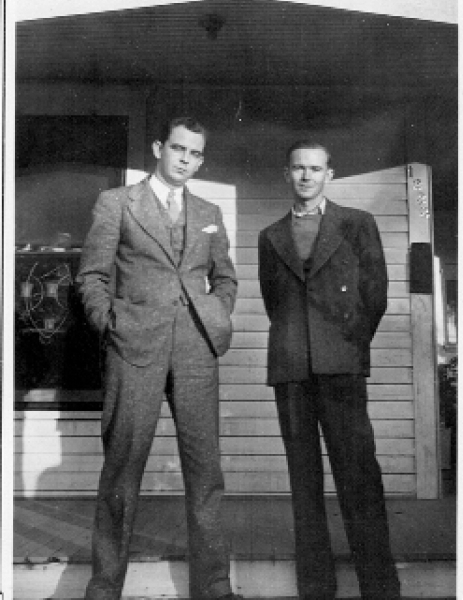
Daly Williams was born in Opelousas, LA on September 26, 1916 and died in Jennings, LA on July 29, 2004. Aside from his military service, he spent most of his life in Jennings, LA. He graduated from Southwestern Louisiana Institute (now the University of Louisiana at Lafayette) in Lafayette, LA. He was nearly finished with his tour of duty in the U. S. Army Air Corps when the Japanese attacked Pearl Harbor. During World War II he was stationed mostly in England, with tours in Russia and parts of North Africa, including Egypt. After his military service he married Marjorie Ann Davis. They have 5 children: Alan, Lois, Barry, Charlie and Virginia. The photo, taken after World War II, shows Daly (right) standing next to his brother Byron (left). Daly was a long time member of James O. Hall Post 19 of the American Legion, Department of Louisiana. On October 5, 1944 Daly wrote this letter to his parents, who shared the letter with the JEFF DAVIS PARISH NEWS. The article with letter chronicles Master Sergeant Daly Williams’ first visit to Moscow during the war:
Master Sergeant Daly Williams is probably the first Jennings soldier to visit Moscow and he has written to his parents of a visit to the Russian capital. The weather, he says, is not yet freezing, but not far from it, giving a foretaste of what Russian winters are like.
Master Sergeant Williams, the son of Mr. and Mrs. W. B. Williams, is with the first American air unit to be sent to the Russian front. His letter follows:
“I have just returned from a short trip to Moscow and since I have little else to write about, I think I will devote most of this letter to a short resume of the journey.
“I was one of a party of fifteen officers, nurses, and enlisted men who departed here Saturday morning and arrived at Moscow shortly after noon that day. After getting settled in our hotel and having a little lunch we were free for the balance of the afternoon to do as we wished. Most of us spent the time wandering around the central section of the city taking in what there was to be seen. We stopped for a short time at the U. S. Military Mission and passed by the American Embassy.
“Saturday evening we went to the ‘Ballet.’ The theater was the ‘Bolshoi Theater’ and is comparable to our Metropolitan Opera. A liberal translation of ‘Bolshoi’ would be ‘grand.’ The theater building is a very large and imposing structure of rather modernistic architectural style.
“I still do not know the name of the ballet we saw but the story centered around the capture of a Ukrainian town by the Tartars in the 10th or 12th Century and deals with attempt of a captor Prince to woo from her lover one of the local maidens. There was little stylistic dancing as such, all the effect was centered around the theme of the story, with everything from sword fights to love scenes portrayed by the dances.
“The ballet was one thing on which the Russians do not stint in any way. The play was beautifully staged and costumed and very well cast. I would estimate the cast included nearly two hundred men and women. The symphony orchestra accompanying the ballet is regarded as the best in the country conducted by their best conductor. In every way the evening was most entertaining and interesting.
“Sunday morning we went on about a three hour tour of the city. Among the places we visited was the park of culture where the Soviets have a tremendous exhibition of captured German war material. This display covers about eighty acres and includes one of almost every type of German war material from 70 ton tanks and 20 field mortars to surgical instruments and individual clothing and equipment. One building had a number of Manikins clothed and equipped as they would be in each of the various branches of the German Army. Some of the equipment we inspected rather closely, among this was a FW 200 four motored German bomber and a new 88 mm anti-tank gun.
“Our mechanical experts have obtained much valuable information from the study of the equipment on display at this exposition.
“Another place visited was a former monastery which has been converted into a museum. On display were many priceless Russian icons, and the robes and vestments of former Priests and Hierarchy of the church in Russia. Most of those vestments were woven of gold and silver threads in very beautiful designs. One entire wall of a very large room was covered with the golden icons and the Minarets and spires and canopies of gold.
“And if course we drove past the Kremlin, the center of the government and present home of Marshal Stalin and other high Russian officials.
‘The Kremlin is a walled area covering about four city blocks which centuries ago was the city proper. The wall was necessary as protection from the attacks of the Mongols. Just outside the Kremlin walls is Red Square at one side of which is placed Lenin’s Tomb.
“I was very lucky to make the trip as yet only a few have made a visit to Moscow. Maybe it is a good thing to be working in the office with all the big wheels.”
